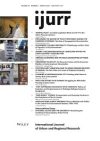Segregation along lines of race/ethnicity and class has created multi‐ethnic and rather class‐homogeneous neighbourhoods in various European cities, commonly labelled as ‘disadvantaged’. Such neighbourhoods are often seen as ‘lacking’ community, as local networks are crucial for belonging and mixed neighbourhoods are too diverse to provide homogeneous identifications. However, in contrast to the understandings of the sociology of community, people might still experience ‘belonging’, yet in different ways. This article argues that we have to focus on the under‐researched ‘time in‐between’ (Byrne, 1978), the absent ties that Granovetter (1973) pointed to, to understand belonging, while moving away from a conception of the anonymous city and from the urban village. This article explores how absent ties affect belonging by empirically sustaining the notion of public familiarity: both recognizing and being recognized in local spaces. Using regression models on survey data from two mixed neighbourhoods in Berlin, Germany, we analyse the importance of neighbourhood use for public familiarity as well as how it relates to residents’ comfort zone: people’s feeling of belonging and their sense that others would intervene on their behalf. Our findings indicate that research on neighbourhoods could benefit greatly from a careful consideration of the ‘time in‐between’.
Details
Written by:
Talja Blokland, Julia Nast
Digital Object Identifier (DOI)
10.1111/1468-2427.12126
About DOI
Read full article as PDF
Read full article as HTML
See the references for this article
